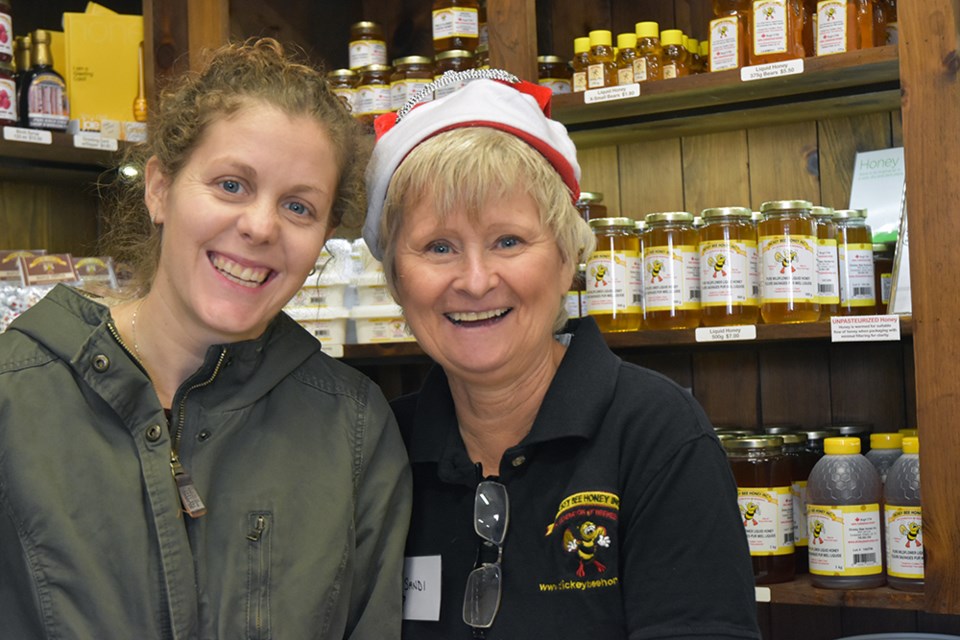Dickey Bee Honey, owned and operated by Peter and Sandi Dickey, describes itself as a fourth-generation honey operation.
But there’s a world of difference between what was begun by Peter’s great-great-grandfather George, and today’s Honey House in Innisfil.
“He probably had three hives,” said Peter Dickey, of the founder of the firm. “A lot of people had bees for their own personal use. They might have had two, three, four hives.”
So how many hives does Dickey Bee Honey have today? “Never enough" to meet the surge of interest in local honey, for health and well-being, he said.
Dickey's dad, Edward, had 75 hives in the Brampton area before he retired.
Peter and Sandi moved to Innisfil in 2000 and continued beekeeping. They built the Honey House on Line 3 of Innisfil, just north of Cookstown, in 2011 — a 372-square-metre facility that allowed them to increase their production, add storage, develop new products and add classroom space.
Diversification has been the key to Dickey Bee Honey’s success. Not only has Dickey Bee developed its own line of salad dressings, condiments, soaps and cosmetics, in addition to its liquid, creamed and comb honey and honey butters, it has also expanded into sales of bee-keeping equipment and supplies.
“There’s a huge demand,” said Peter Dickey. “We teach beekeeping here. We sell the bees, we sell the equipment.”
His students have ranged in age from 18 to 75 — setting up hives on anything from 0.4 to 41 hectares. In the last class, 60 per cent of neophyte beekeepers were women.
“Ten years ago, it was 60-40 the other way,” Dickey noted.
Dickey Bee Honey also offers Adopt-a-Bee and Rent-a-Hive programs for those not quite ready to set up their own apiary, but interested in a supply of honey. Hives are set up in mid-May, the bees are left to pollinate the garden, then overwinter, “and at the end of the day, you get the honey, and I take them away,” said Dickey.
The Dickeys added another 186 sq. m. to the Honey House in 2015, including expanded retail space and a second classroom. They also registered as a Canadian Food Inspection Agency-inspected producer “for consumer confidence.” The certification means their honey can be labelled “Canada No. 1” and exported around the world.
All of the honey produced at Dickey Bee is unpasteurized.
“When you pasteurize honey, you kill all the nutritional value,” Dickey said. The process breaks down the natural sugars — the balance of fructose and sucrose —which means that pasteurized honey will never crystallize, no matter how long it sits on the shelf.
Crystallization is a natural process, Dickey explained, and easily fixed. Gently heat the honey to return it to a liquid state. “Just don’t overheat it,” to ensure the nutritional and health properties are not damaged.
Four large tanks are used for finishing liquid honey, creamed honey, buckwheat honey, and honey butters, and taken into the extraction room, where the frames or “honey supers” taken from the hives are emptied.
Bees cleverly cap the honeycombs with wax, to keep the honey from flowing in the hive. That wax has to be scraped off — at one time with a manual tool called a capper or comb, now mechanically — before the honey can be extracted.
Nothing is wasted, said Dickey. The wax cappings are melted, filtered and poured into blocks, to be used to make candles, cosmetics and honey soaps.
The bees also make propolis, a resin-like material with antibacterial and antiviral properties, that helps to keep the hive disease-free. “We harvest it and put it into tincture form, for sore throats,” said Dickey.
And Dickey Bee Honey harvests the pollen carried by the worker bees. “It has a lot of benefits. I take that in my cereal, a smoothie’s good, or on yogurt.”
From the wood-working shop where the wooden ‘honey super’ frames are assembled, using Ontario pine, to the cold storage and walk-in freezers where the honey is stored for shipment, visitors were taken through the whole process and given a few marketing tips along the way.
Expensive manuka honey from New Zealand, being touted for its health properties? “It used to be fed to cattle,” said Dickey. “Any unpasteurized honey has medicinal properties. It’s all marketing.”
There has been concern, in recent years, over the health of the honey bee, with some pointing a finger at pesticides, some at climate, some at disease. For whatever reason, this year “the bees are great. We had a great crop," Dickey said.
The mite loads are down, neonicotinoid pesticide use is down, the weather co-operated — “all contributing to a better over-wintering success,” he said.
The bees are all hibernating now, and will remain snug in their hives until April — but the Dickey Bee Honey House continues to be a hive of activity at the retail shop, which offers honey and maple syrup products and gift baskets.
Dickey Bee Honey’s Honey House and retail outlet are located at 4031 Line 3 in Innisfil, north of Cookstown. For more information, see dickeybeehoney.com or call 705-458-1258.



